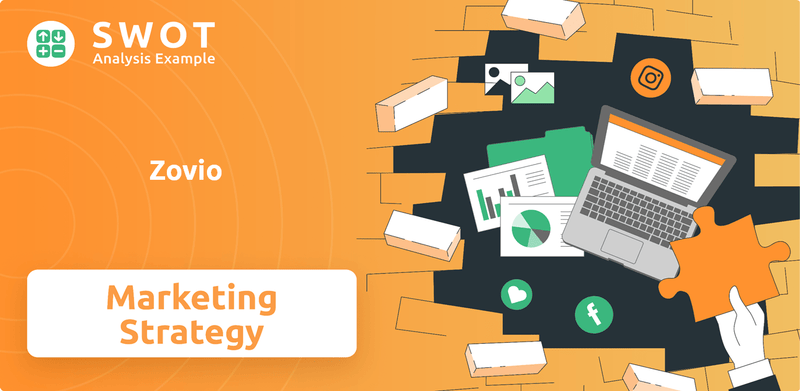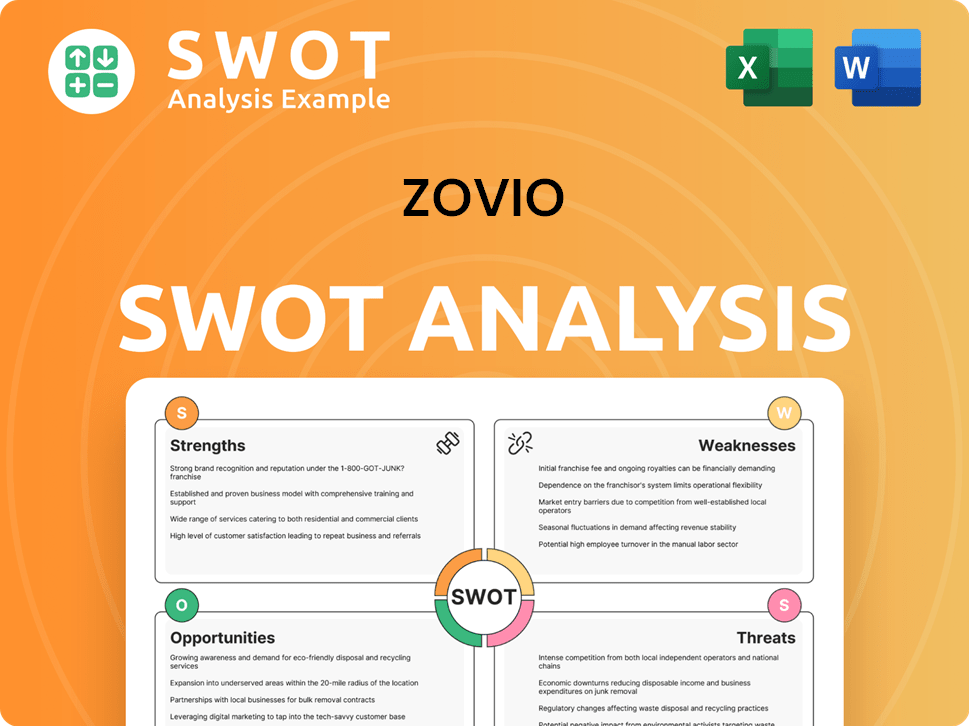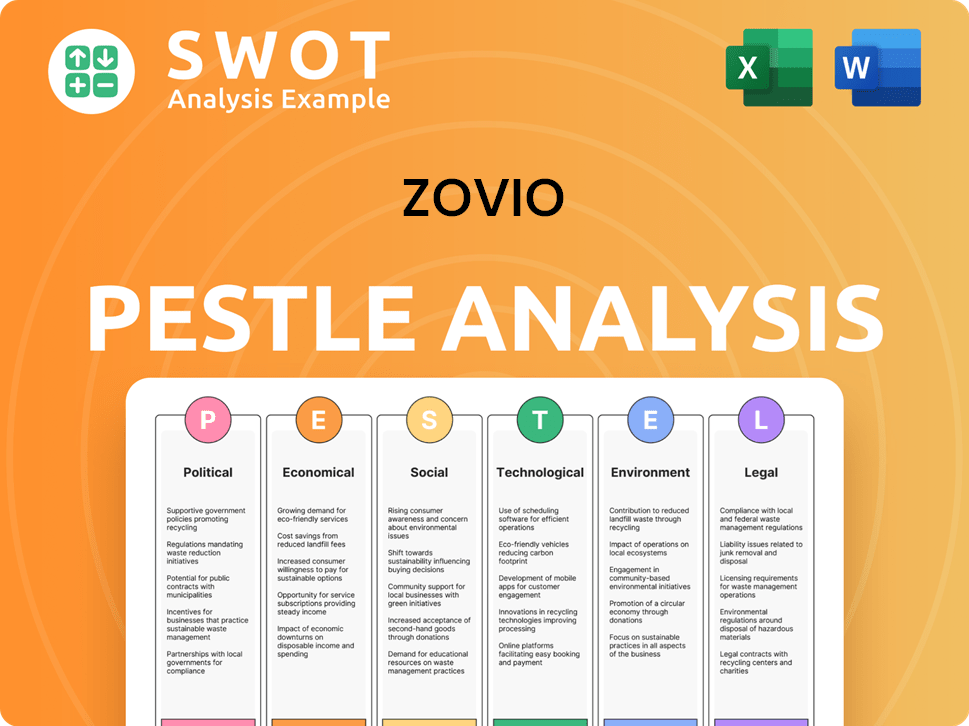Zovio Bundle
What Went Wrong with Zovio's Sales and Marketing?
Zovio, a once-promising EdTech company, navigated a turbulent path marked by strategic shifts and ultimately, liquidation. From its origins as Bridgepoint Education to its pivot towards technology-driven solutions, Zovio's journey offers a fascinating case study in the evolving education landscape. Understanding Zovio's Zovio SWOT Analysis is crucial to grasping its sales and marketing strategies.

This analysis delves into Zovio's sales strategy, marketing tactics, and the core elements of its business model, providing valuable insights for investors, business strategists, and anyone interested in the EdTech sector. We'll examine how Zovio's approach to customer acquisition, its digital marketing strategy, and its efforts to build a brand within a competitive market. Furthermore, we will explore Zovio's target market, its revenue model, and how it attempted to differentiate itself from its competitors.
How Does Zovio Reach Its Customers?
The core of the Zovio sales strategy involved forging partnerships, primarily focusing on business-to-business (B2B) relationships. This approach differed significantly from direct-to-consumer models. Instead, the company offered technology and services to support online learning, including online program management (OPM), curriculum development, and student support.
Initially, under the name Bridgepoint Education, the company directly operated for-profit online universities. However, after rebranding to Zovio in 2019, the Zovio business model shifted towards providing educational technology services to other institutions. A key move was selling Ashford University to the University of Arizona in 2020. This transition led to a 15-year contract with the University of Arizona Global Campus (UAGC), where Zovio provided OPM services.
The Zovio marketing strategy also included partnerships with employers through its Zovio Employer Solutions (ZES) program. By June 2022, Zovio had partnerships with over 1,300 employers. These collaborations aimed to optimize corporate tuition assistance programs, enabling employees to enroll in university degree programs or discounted courses. Over 10,000 students were enrolled in these programs. A notable partnership was with Delta Air Lines in 2019 to enhance tuition assistance benefits.
Zovio's sales channels were built on strategic partnerships with higher education institutions and employers. The company focused on providing technology and services to support online learning. These partnerships were crucial for lead generation and customer acquisition.
The sales channels evolved from direct operation of online universities to providing educational technology services. The sale of Ashford University to the University of Arizona marked a significant shift. This transition led to a long-term contract for OPM services with UAGC.
Zovio's Employer Solutions program aimed to optimize corporate tuition assistance programs. These partnerships allowed employees to enroll in degree programs or discounted courses. This approach helped expand the reach and effectiveness of the company's services.
Zovio divested subsidiaries like Fullstack Academy and TutorMe as part of its liquidation process. TutorMe was sold for $55 million in May 2022, and Fullstack Academy was sold in November 2022. These sales were part of a strategic restructuring.
The Zovio sales strategy relied heavily on partnerships with educational institutions and employers. This B2B approach was central to its revenue model. Understanding the Target Market of Zovio is key to analyzing the effectiveness of these channels.
- Strategic Partnerships: Focused on long-term contracts with universities and corporations.
- B2B Model: Provided technology and services to support online learning, rather than direct student enrollment.
- Employer Solutions: Optimized corporate tuition assistance programs, increasing student enrollment.
- Divestitures: Sold off subsidiaries to streamline operations and focus on core services.
Zovio SWOT Analysis
- Complete SWOT Breakdown
- Fully Customizable
- Editable in Excel & Word
- Professional Formatting
- Investor-Ready Format

What Marketing Tactics Does Zovio Use?
The marketing tactics employed by Zovio were designed to boost brand awareness, generate leads, and drive sales within the higher education and employer sectors. Given its business-to-business (B2B) model, the company heavily emphasized establishing partnerships and showcasing the value of its educational technology services. This approach was crucial for achieving its goals and expanding its market presence.
Digital strategies played a significant role in Zovio's approach. The company utilized 'advanced data and analytics' to improve the learner experience and deliver strong outcomes for its partners. This data-driven approach likely involved customer segmentation and personalization, tailoring offerings to the specific needs of institutions and employers. Zovio also leveraged technology platforms and analytics tools for data governance and business intelligence reporting.
The marketing mix changed as Zovio transitioned from a for-profit college operator to an EdTech services provider. This shift required a focus on demonstrating its capabilities in online program management, curriculum development, and student support to potential institutional clients. The rebranding from Bridgepoint Education to Zovio in 2019 was a key marketing innovation, reflecting its new identity as an education technology services company.
Zovio's Zovio marketing strategy heavily relied on digital tactics. The company utilized data and analytics to enhance the learner experience and tailor offerings to its partners.
A key aspect of the Zovio sales strategy was building partnerships. The company collaborated with employers, such as Delta Air Lines, to promote educational opportunities.
The 2019 rebranding from Bridgepoint Education to Zovio was a significant marketing move. This reflected its shift to an education technology services provider, including a new brand positioning and visual identity.
Zovio's business model incorporated a data-driven approach. This involved using analytics to understand customer needs and improve service delivery.
The company's B2B model meant that marketing efforts were aimed at institutions and employers. This involved demonstrating the value of its educational technology services.
Marketing tactics evolved as Zovio transitioned its focus. The company adapted its approach to align with its new identity as an EdTech services provider.
Zovio's marketing tactics focused on digital channels, partnerships, and rebranding to align with its evolving business model. This included a data-driven approach to understand and meet the needs of its target market. For a deeper dive into the competitive landscape, you can read about it in the Competitors Landscape of Zovio.
- Zovio's target market consisted of higher education institutions and employers.
- The company's Zovio's competitors in the EdTech space included companies offering similar services.
- Zovio's revenue model was based on providing educational technology services to its partners.
- The company used a range of Zovio sales and marketing tactics to acquire customers.
Zovio PESTLE Analysis
- Covers All 6 PESTLE Categories
- No Research Needed – Save Hours of Work
- Built by Experts, Trusted by Consultants
- Instant Download, Ready to Use
- 100% Editable, Fully Customizable

How Is Zovio Positioned in the Market?
Zovio, formerly Bridgepoint Education, positioned itself as an education technology services company. The company partnered with higher education institutions and employers. Its core message focused on helping learners and leaders achieve their goals by addressing the skills gap, offering flexible, high-quality educational opportunities. The company's mission was articulated as 'to help everyone be in a class of their own.'
The rebranding in 2019 introduced a visual identity designed to be purposeful and bold. The bright orange logo symbolized energy and possibility. Its multi-component shape was intended to position Zovio as an 'intelligence hub'. This hub empowered users with personalized insights. This strategy aimed to differentiate Zovio from its past as a for-profit college operator.
Zovio's Zovio sales strategy and Zovio marketing strategy targeted its audience by promising innovation, personalization, and improved outcomes. This was particularly relevant in addressing the skills-to-employment challenge. The emphasis on using 'advanced data and analytics' to enhance the learner experience reinforced its position as a technology-driven solution provider. Brand consistency was a key consideration to resonate with both external partners and its large employee base. For more insights, explore the Growth Strategy of Zovio.
Zovio's Zovio's target market included higher education institutions, employers, learners, and leaders. The company aimed to provide solutions that bridged the skills gap. It offered flexible, high-quality educational opportunities.
The online education market was valued at approximately $100 billion in 2024. The broader EdTech market was valued at $137.8 billion in 2024. Zovio aimed to differentiate itself through its comprehensive services and data-driven approach within this competitive landscape.
Zovio sought to stand out by offering comprehensive services and a data-driven approach. This included personalized solutions and an emphasis on advanced data and analytics. It focused on improving learner outcomes and addressing the skills-to-employment challenge.
Despite its efforts, Zovio faced significant challenges, including legal and regulatory issues. Financial instability impacted its brand perception. These challenges ultimately led to the cessation of its operations.
Zovio Business Model Canvas
- Complete 9-Block Business Model Canvas
- Effortlessly Communicate Your Business Strategy
- Investor-Ready BMC Format
- 100% Editable and Customizable
- Clear and Structured Layout

What Are Zovio’s Most Notable Campaigns?
The Zovio sales strategy and Zovio marketing strategy evolved significantly as the company transitioned from a for-profit college operator to an education technology services provider. Key campaigns and strategic initiatives were central to this transformation, aiming to reposition the company and drive growth through partnerships and service offerings. These efforts included rebranding, strategic alliances, and employer partnerships, all designed to attract new customers and increase revenue. Understanding these campaigns provides insight into how Zovio attempted to navigate the competitive landscape and achieve its business objectives.
One of the most important aspects of Zovio's business model was its ability to adapt to changes in the education market. This flexibility was demonstrated through a series of strategic shifts, including rebranding and partnerships. The company's approach to marketing and sales was also impacted by its changing business focus. By examining these campaigns, we can gain a better understanding of how Zovio sought to position itself in the market and generate revenue.
Several strategic initiatives and partnerships served as defining moments for Zovio, each with specific objectives and outcomes. These campaigns were crucial in shaping the company's trajectory and influencing its financial performance. The following details some of the most impactful campaigns.
In April 2019, the company rebranded from Bridgepoint Education to Zovio. This Zovio sales strategy was designed to reposition the company as an education technology services provider. The rebranding included a new name, visual identity, and brand voice, emphasizing innovation and a data-driven approach. This shift was critical for attracting new institutional and employer partnerships.
In 2020, Zovio entered into a strategic agreement with the University of Arizona, involving the sale of Ashford University. The agreement included a long-term contract for Zovio to provide online program management (OPM) services to UAGC. This partnership was a major revenue stream, with projections of 19.5% of UAGC's tuition and fees revenue. However, the contract was terminated in August 2022.
By June 2022, Zovio had partnered with over 1,300 employers through its ZES program. The program aimed to bridge the education-to-employment gap by providing flexible upskilling programs and degrees to working adults. A notable collaboration was with Delta Air Lines in 2019. By June 2022, over 10,000 students were enrolled in ZES-supported programs.
In October 2022, shareholders approved an asset liquidation and dissolution plan. This was a response to persistent financial losses and the termination of key partnerships. As part of this plan, Zovio sold its subsidiaries, TutorMe for $55 million in May 2022 and Fullstack Academy in November 2022. These sales aimed to manage liabilities and distribute remaining assets.
These campaigns reflect Zovio's efforts to adapt to the changing education market. The rebranding aimed to reposition the company, while the UAGC partnership was intended to provide a significant revenue stream. The ZES program sought to expand enrollment through employer partnerships. However, the termination of the UAGC contract and the asset liquidation plan highlight the challenges faced by Zovio.
- The rebranding aimed to reposition the company.
- The UAGC partnership was intended to provide a significant revenue stream.
- The ZES program sought to expand enrollment through employer partnerships.
- The asset liquidation plan indicates financial challenges.
Zovio Porter's Five Forces Analysis
- Covers All 5 Competitive Forces in Detail
- Structured for Consultants, Students, and Founders
- 100% Editable in Microsoft Word & Excel
- Instant Digital Download – Use Immediately
- Compatible with Mac & PC – Fully Unlocked

Related Blogs
- What are Mission Vision & Core Values of Zovio Company?
- What is Competitive Landscape of Zovio Company?
- What is Growth Strategy and Future Prospects of Zovio Company?
- How Does Zovio Company Work?
- What is Brief History of Zovio Company?
- Who Owns Zovio Company?
- What is Customer Demographics and Target Market of Zovio Company?
Disclaimer
All information, articles, and product details provided on this website are for general informational and educational purposes only. We do not claim any ownership over, nor do we intend to infringe upon, any trademarks, copyrights, logos, brand names, or other intellectual property mentioned or depicted on this site. Such intellectual property remains the property of its respective owners, and any references here are made solely for identification or informational purposes, without implying any affiliation, endorsement, or partnership.
We make no representations or warranties, express or implied, regarding the accuracy, completeness, or suitability of any content or products presented. Nothing on this website should be construed as legal, tax, investment, financial, medical, or other professional advice. In addition, no part of this site—including articles or product references—constitutes a solicitation, recommendation, endorsement, advertisement, or offer to buy or sell any securities, franchises, or other financial instruments, particularly in jurisdictions where such activity would be unlawful.
All content is of a general nature and may not address the specific circumstances of any individual or entity. It is not a substitute for professional advice or services. Any actions you take based on the information provided here are strictly at your own risk. You accept full responsibility for any decisions or outcomes arising from your use of this website and agree to release us from any liability in connection with your use of, or reliance upon, the content or products found herein.